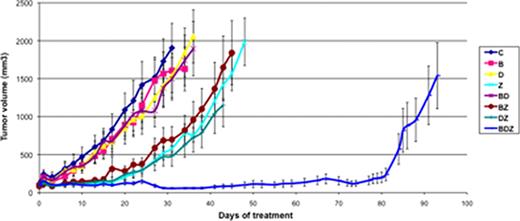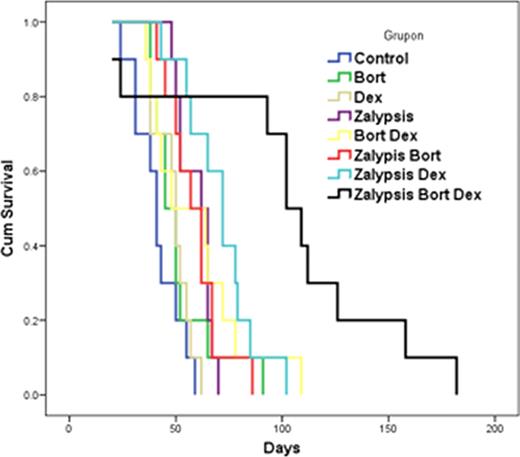Abstract
Abstract 3003
During the last years, several novel drugs combinations have changed the outcome of Multiple Myeloma (MM) patients; nevertheless, relapse is still the rule for most of these patients, and, therefore, other drugs with novel mechanisms of action are required. The current research in this topic is usually based on the addition of novel drugs to standard of care combinations in order to try to increase their efficacy. Bortezomib + steroids has turned out to be one of these standards, both for induction therapy before high dose melphalan and also for non-trasplant candidates. Zalypsis is a novel marine compound with remarkable preclinical activity in MM, which is currently being explored in a phase I/II trial. We explored the preclinical efficacy of the triple combination of zalypsis, bortezomib and dexamethasone in different models and investigated its mechanism of action.
This combination showed high potency when compared to the respective single agents and double combinations, and, in fact, the analysis by the Calcusyn software, evidenced combination indexes in the highly synergistic range (CI 0.2–0.6). This effect was observed not only in the MM1S cell line, but also in freshly isolated cells from MM patients and, most importantly, in a subcutaneous xenograft of a human plasmocytoma in SCID mice. In this last model, we used suboptimal doses of bortezomib and dexamethasone (0.1 mg/Kg and 1 mg/Kg respectively ip, 5 days per week indefinitely) combined with an active dose of zalypsis (0,75 mg/Kg iv weekly for three total doses). Probably due to the low doses used, the double combination of bortezomib + dexamethasone did not show much effect as compared to the control group, and neither bortezomib nor dexamethasone alone could significantly improve the efficacy of Zalypsis. Nevertheless, when the three drugs were combined together, the tumor volume drastically shrunk with differences highly statistically significant (p<0.001) (Figure 1). These results also translated into an improvement in survival for those mice treated with the triple combination. Median survival (range) of 102 days (85-118) for the triple vs 72 days (61-82) for the best double (Zalypsis + Dexamethasone) (Log Rank < 0.001) (Figure 2). Regarding toxicity, a moderate body weight loss was observed in all mice receiving combinations that included Zalypsis, which completely recovered after stopping treatment with this drug. Two early deaths (out of 10 mice) were also observed in the group of mice assigned to the triple combination group.
These results impelled us to investigate the mechanisms relying under the synergy observed. The triple combination induced caspase dependent apoptosis, demonstrated by Annexin V induction and cleavage of caspases 3, 7, 8, 9 and also PARP. By contrast, the activity on the cell cycle was not evident for this combination, indicating a preferential apoptotic effect and not a substantial antiproliferative one. Of note, two mechanisms seem to be specifically associated to the combination of the three agents: 1. A significant release of Endonuclease-G and Cytochrome-C from the mitochondria into the cytosol was observed, suggesting a role for the intrinsic pathway of apoptosis; and 2. One of the most significant changes induced by the combination was an increase in the levels of AIF (apoptosis inducing factor) in the cytosol and nucleus, which is probably indicating the involvement of caspase independent mechanisms. In line with these results, pretreatment with ZVAD was only able to partially rescue from apoptosis, also indicating the potential activation of a dual mechanism: dependent and independent of caspases.
Finally, we had previously shown that Zalypsis acts, at least partially, through the induction of DNA damage, based on a p53 dependent mechanism. In this study, the addition of bortezomib and dexamethasone, further increased the H2AX phosphorylation induced by Zalypsis, suggesting a potentiation of the DNA damaging effect; and the combination was also associated with a clear increase in the levels of p53 protein by WB as compared with the agents in monotherapy. The study of the mechanism of action is currently being completed and final results will be presented at the meeting.
In summary, the combination of zalypsis + bortezomib + dexamethasone shows high synergy in MM through the activation of different pathways, and these results provide the rationale for its use in relapsed/refractory MM patients.
Cuevas:Pharmamar: Employment. Avilés:Pharmamar: Employment. Pandiella:Pharmamar: Research Funding. San Miguel:Pharmamar: Research Funding; Millenium: Consultancy, Research Funding.
Author notes
Asterisk with author names denotes non-ASH members.



This feature is available to Subscribers Only
Sign In or Create an Account Close Modal